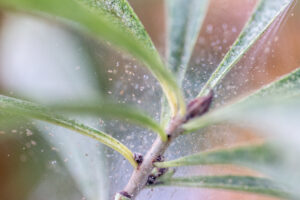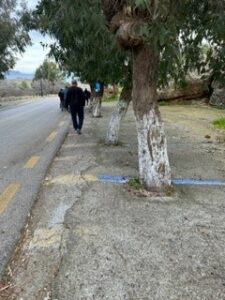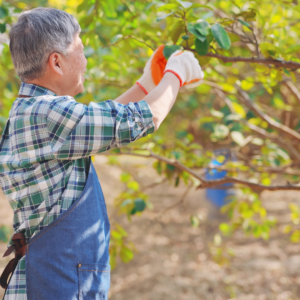Insects That Infest Trees & How to Get Rid of Them
By : Rita Stadler
As homeowners spend more time outside mowing the grass, tending to gardens, soaking up the sun, or playing with their kids, they start to notice more about the ecosystems of their front and backyards. One common occurrence that may draw their attention is bugs crawling all over the trees.
Keeping trees healthy is a vital and economical part of not only maintaining your own yard space, but of the neighborhood overall as well. Trees provide homes for many creatures, help clean the air, and also provide shade that can help lower the AC bill. If you notice pests on your trees that may be causing damage, it’s time to take action.
Damage Tree Pests Can Cause
Trees are vulnerable to a variety of insect infestations, which can weaken their health, affect their appearance, and even lead to their demise if left unaddressed. Recognizing the signs of an insect problem early on is crucial to implementing appropriate interventions and preserving the well-being of your trees.
Here are some signs of damage to look for:
- Leaf Damage : One of the first indications of an insect problem is visible damage to the tree’s leaves. Look for signs of chewed or skeletonized leaves, irregular patterns of holes or notches, or sections of missing foliage. Leaf discoloration, wilting, or premature leaf drop can also signify insect activity.
- Pests : Observing the presence of actual pests on your tree is a clear indication of an infestation. Look for insects, larvae, or their eggs on the leaves, branches, or trunks. Depending on the pest, you may notice small aphids, webbing produced by spider mites, or cocoons formed by caterpillars.
- Bark Damage : Certain insects can cause visible damage to the tree’s bark. Look for signs of tunnels, tracks, or galleries created by borers or beetles. Bark that appears cracked, peeling, or discolored can also indicate the presence of insect pests. Excessive sap oozing from the tree can also indicate that scale insects or aphids have infested and damaged the tree.
- Large Growths or Gall-like Growths : Some insects, such as gall wasps or aphids, induce abnormal growths on trees known as galls. These galls can take the form of round, swollen bumps or deformed foliage. If you notice unusual growths on your tree, it may be a sign of insect infestation.
- Sawdust or Frass : Sawdust-like material, known as frass, is the waste produced by certain wood-boring insects. If you observe small piles of frass at the base of your tree or within bark crevices, it suggests the presence of borers or beetles.
Common Bugs that Can Kill or Damage Trees
Insects play a significant role in the ecosystem, but when it comes to trees and shrubs, some can be quite harmful. Below are some of the most common bugs that could cause damage to trees.
- Aphids : These tiny insects feed on the sap of trees and shrubs, causing leaves to curl, distort, and yellow. They reproduce rapidly and can damage plant growth if left unchecked. They produce a sweet waste called honeydew that can attract other insects. Maples, oaks, pines, and poplars are common trees that aphids will infest.
- Caterpillars : Certain caterpillars, like tent caterpillars/worms and gypsy moth larvae, can defoliate trees, weakening them and hindering their ability to thrive. Gypsy moth larvae feed especially well on hardwood trees like maple, oak, birch, and elm.
- Borers : Wood-boring insects, such as the emerald ash borer or bronze birch borer, tunnel into the bark and wood of trees, leading to dieback and ultimately, tree mortality. The Emerald ash borer is easy to spot as it has a dark metallic green coat and as the name implies focuses mostly on creating holes into ash trees.
- Scale Insects : Scale insects attach themselves to tree branches, sucking sap and weakening the plant. They often appear as small, round, or oval-shaped bumps. Usually scale insects are found in early spring and are attracted to maple, willow, lilac, dogwood, and ash trees.
Does it matter if you notice a large amount of ants on a tree?
Generally speaking, most ants do not cause damage to trees. However, a large amount of ants in a tree could be an indication that some harmful pests have taken residence. Ants are attracted to sugary foods and the honeydew that aphids produce is exactly that. So a large amount of ants on a tree could be a warning that you have other issues present.
- Carpenter ants, much like the name suggests, love decayed wood. These large ants will dig into the decayed areas as an entry point into the healthy parts of the tree. A tree that is infested with carpenter ants can indicate that the tree is suffering from large amounts of decay and is structurally unsound.
- Fire ants create large sandy mounds at the base of trees and can stunt growth in young trees. They also sting anything that disturbs their mounds or encroaches on their area. Their stings leave painful red blisters. Keep children and pets away from these areas and use caution when dealing with fire ant mounds.
How to Protect Trees from Insects
Naturally, trees provide some insects places to live. To keep harmful insects away from your trees, it is vital to conduct regular inspections. Observe the leaves, branches, and trunk for signs of pest activity, such as chewed foliage, webbing, or tunnels. Early detection allows for prompt action and prevents infestations from becoming severe.
There are ways to help protect trees from insect damage. We will explore effective methods to keep harmful insects out of trees, including a well-known technique of painting tree trunks with lime. By implementing these strategies, you can protect your trees and ensure their continued growth and beauty.
Painting Tree Trunks With Lime
Lime washing trees is a traditional method used to protect the bark from harmful insects and fungal diseases while also providing other benefits. To lime wash a tree, you’ll need hydrated lime, water, and a paintbrush. Start by mixing the hydrated lime with water to create a paint-like consistency. The ratio of lime to water may vary, so it’s recommended to follow the instructions provided with the specific lime product. Once the mixture is ready, use a paintbrush to apply it evenly to the tree trunk, starting from the base and moving upward.
Make sure to cover the entire trunk, including any exposed roots or lower branches. Allow the lime wash to dry completely before applying a second coat if desired. Lime wash acts as a physical barrier, making the tree trunk less attractive to insects and pests. It also has antifungal properties, helping to prevent the growth and spread of fungal diseases. Additionally, lime wash can provide protection against sunscald, a condition caused by excessive sunlight exposure, by reflecting sunlight and reducing temperature fluctuations on the bark.
While lime washing can be an effective method to protect trees, it’s important to consider a few factors. Lime washing is generally suitable for deciduous trees with thicker bark and should be avoided on young or newly planted trees. Additionally, it’s crucial to select the appropriate type of lime and ensure proper application. Consulting with local arborists or tree care professionals can provide valuable guidance on the specific lime product and application method best suited for your tree species and local conditions. Remember to prioritize eco-friendly practices and consider alternative methods alongside lime washing to maintain a healthy and sustainable tree environment.
Keep Trees Properly Maintained
Proper pruning and trimming techniques play a vital role in maintaining the health and longevity of trees. When done correctly, pruning promotes tree growth, improves structure, enhances aesthetics, and reduces the risk of disease and damage.
The first step is to identify the goals of pruning, whether it’s removing dead or diseased branches, shaping the tree for better structure, or thinning out crowded areas. It’s essential to use sharp, clean pruning tools and make precise cuts at the appropriate locations, such as just outside the branch collar. Pruning during winter or late fall is generally recommended to minimize stress on the tree.
Regular trimming of smaller branches can also help maintain a desirable shape and prevent branches from rubbing against each other. Proper pruning not only keeps trees healthy but also improves their overall appearance, ensures safety, and allows for better air circulation and light penetration.
Keep Areas Around Trees Properly Cleaned
Regularly removing debris from around trees is essential for their overall cleanliness and health. Fallen leaves, branches, twigs, and other organic matter can accumulate and provide a breeding ground for pests, fungi, and diseases. Remove debris promptly, especially during the autumn season when leaves tend to fall in abundance. Use a rake or leaf blower to gather and dispose of fallen leaves and other debris away from the tree’s base. Regular cleaning minimizes the risk of potential issues and keeps the area surrounding the tree tidy.
Effective weed control is crucial for maintaining clean areas around trees. Weeds compete with trees for water, nutrients, and sunlight, potentially hindering their growth and overall health. Regularly inspect the area around the tree for weeds and remove them promptly. Applying a layer of mulch around the tree’s base can help suppress weed growth, conserve moisture, and enhance the visual appeal of the tree’s surroundings. Remember to choose mulch that is appropriate for the tree species and avoid piling it against the tree trunk, as it can cause moisture-related issues.
Promote the Growth of Beneficial Insects.
Just as there are some harmful bugs, there are those that are good for trees, gardens, and shrubs. Most of these insects will either help eradicate the harmful bugs or they will pollinate and help grow surrounding plants.
Some beneficial insects include:
- Bees : Bees play a crucial role in pollination, aiding in the reproduction of trees and shrubs. Encouraging a bee-friendly environment with native plants helps support their populations.
- Ladybugs : Ladybugs are voracious predators of aphids and other soft-bodied pests. Introducing ladybugs or attracting them to your garden can help control harmful insect populations naturally. You can attract ladybugs to your yard by planting flowers or herbs like Dill, Cilantro, Chives, Fennel, Caraway, Marigold, or Yarrow.
- Praying Mantises : These fascinating insects are skilled predators, feeding on a variety of insects and acting as natural pest control agents.
- Lacewings : Lacewing larvae are ferocious predators that feed on aphids, caterpillars, and other small insects, making them valuable allies in keeping harmful pests at bay. Lacewings can be attracted to your yard by planting similar plants that attract ladybugs.
Remove Trees
Pests that infest trees and will continue to move to other trees to kill/damage. If you see a sudden decline in the overall health of the tree with no signs of trauma you should call a professional arborist. Hollow or rotten trees are dangerous. Trees in this condition can fall at any time, but especially during storms.
If you are looking to remove a tree, you should consult a professional arborist or tree removal company to make sure that there is no damage to the surrounding area. Also, they can inspect the surrounding trees to see if the infestation is an isolated occurrence.
Getting Rid of Infestations
The best line of defense against an infestation is providing an environment where the tree can withstand the occasional pest attack. Taking the steps above will help to put your tree in a positive preventative position. If you suspect that your tree has been infested by an invasive species and the tree is beyond repair, please contact a professional.
Having an outdoor event in your backyard soon? Try these tips to keep the bugs away and don’t forget to have Stay Away® Mosquitoes on hand to keep the mosquitoes, gnats, flies and other pests away.








